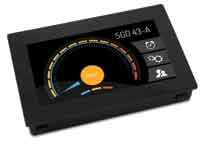
Posted to News on 19th Sep 2014, 00:00
Virtual instrumentation goes back to the panel
For operators, who generally can't see what is happening inside an industrial machine visually, instruments are a crucial tool in checking and ensuring that industrial processes and equipment is working correctly. Ben Savage, PanelPilot manager at Lascar Electronics, explains.

>Traditionally industrial instrumentation systems were made up of pre-defined hardware components, which were completely specific to their stimulus, analysis or measurement function. These were very simple, but accurate, hardware tools and there were variants for every conceivable application. Even on little pieces of equipment there would be a dial or a digital readout telling the operator something useful - speed, temperature, number of hours since last service, or a whole host of other parameters.
>However, because these instruments were entirely hardware-based, they were generally very limited. There were no 'multi-functional' instruments; you needed a specific instrument for a specific function. Moreover, the reality was that these purely hardware instruments were actually only providing a very narrow piece of information: what is the status right now on this one parameter.
>Then about 20 years ago things started to change. Computers replaced the old style hardware instruments, enabling a lot of the complex and function-specific hardware to be replicated in software. Virtual instrumentation was born. By implementing measurement tools in software using standard computer hardware, virtual instruments did away with the need for dedicated hardware for specific functions. A computer could be made to replicate any instrument.
>That said, to begin with virtual instruments were pretty basic. They didn't really add any new functionality. But as they developed and became mainstream so manufacturers realised that virtual instruments didn't have to look like the old style panel-meters and test equipment they replaced. In fact manufacturers and operators realised that computer graphics could actually more meaningfully represent the signals the instruments were measuring and bring together multiple inputs on one display, in a form that made more sense to an operator.
>Virtual instruments also made it much easier to display whether a measurement is rising or falling, and how quickly it is changing. For a lot of applications this was key: just the number wasn't enough and showing this signal movement was a significant improvement on what could be shown with a basic needle or a digital display.
>Taken together, all of these advantages also had an added benefit for organisations as the increased ease of use and understanding provided by virtual instrumentation enabled operators to be more productive and arguably meant that you could use 'less skilled' operators to do the monitoring of equipment.
>For all its advantages, it is easy for virtual instrumentation to be 'over-specified'. The fact is that a computer, in whatever guise, is simply over the top for a lot of applications in terms of cost, set-up time, reliability and size. For more straightforward requirements, virtual instruments can simply be just too big or too expensive to even consider. However, regardless of application, operators would rather have the flexibility of a virtual instrument, together with the functional and aesthetic benefits it brings. But they need it in a small, cost effective and self-contained box that can be easily mounted in a standard panel housing.
>As a result instruments are coming full circle and we are now starting to see the emergence of new 'hybrid' systems that merge the customisability of virtual instruments, with the ease of use and low cost of traditional instruments. It seems virtual instruments are going back to the panel.
>This doesn't signal the end of virtual instruments, nor of traditional instruments for that matter. There will still be applications where a fully-fledged virtual instrument is required; equally there still remains a need for simple hardware instruments. But ultimately operators will nearly always want the best of both worlds - low cost, minimal set up, small size, but with the interface and data capabilities of a virtual instrument. Consequently, these hybrid systems, such as Lascar's own recently launched PanelPilotACE, are an interesting new product category that we believe has significant growth potential.
Module House
Whiteparish
SP5 2SJ
UNITED KINGDOM
+44 (0)1794 884567 01425 655655








